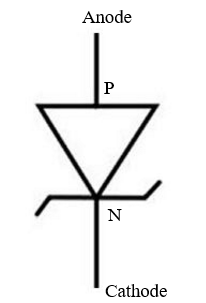
The schematic symbol of light emitting diode is (LED)
A.

B.

C.

D.





Answer
587.4k+ views
Hint: Light Emitting Diode also known as LED, is a semiconductor device that converts the electrical energy into light energy. It can emit a bandwidth of visible light at different wavelengths and invisible infrared for remote controls.
Complete step-by-step answer:
The Light Emitting Diode is a special type of diode. It can pass current in its forward direction but blocks the current flow in reverse direction. It is made up of a thin layer of heavily doped semiconductor material. When it is forward biased, it emits light at a wavelength. The PN junction of an LED is surrounded by transparent epoxy resin to protect from vibration and shock. The symbol of LED is similar to a normal diode, but it has arrows pointing away from the diode which indicates that light is being emitted. The symbol is the same for all colour LEDs.
The second option shows the symbol of Light Emitting Diode.
The first option represents a photodiode, where it has a simple diode symbol with arrows striking towards the diode which points the direction of light.
The third option represents a simple PN junction diode. The symbol is a triangle pointing towards a bar which indicates that current flows in one direction towards the striped end.
The fourth option represents the symbol of Zener diode, where electric current flows from both anode to cathode and vice versa. The symbol is similar to a normal PN junction diode but with bent edges on the vertical bar.
Therefore, the correct answer for the given question is option (B).
Note: Light Emitting Diodes are free of harsh chemicals and do not emit Ultraviolet rays. LEDs are used in many applications like lighting, automotive headlamps, screen displays, traffic lights and many.
Complete step-by-step answer:
The Light Emitting Diode is a special type of diode. It can pass current in its forward direction but blocks the current flow in reverse direction. It is made up of a thin layer of heavily doped semiconductor material. When it is forward biased, it emits light at a wavelength. The PN junction of an LED is surrounded by transparent epoxy resin to protect from vibration and shock. The symbol of LED is similar to a normal diode, but it has arrows pointing away from the diode which indicates that light is being emitted. The symbol is the same for all colour LEDs.
The second option shows the symbol of Light Emitting Diode.
The first option represents a photodiode, where it has a simple diode symbol with arrows striking towards the diode which points the direction of light.
The third option represents a simple PN junction diode. The symbol is a triangle pointing towards a bar which indicates that current flows in one direction towards the striped end.
The fourth option represents the symbol of Zener diode, where electric current flows from both anode to cathode and vice versa. The symbol is similar to a normal PN junction diode but with bent edges on the vertical bar.
Therefore, the correct answer for the given question is option (B).
Note: Light Emitting Diodes are free of harsh chemicals and do not emit Ultraviolet rays. LEDs are used in many applications like lighting, automotive headlamps, screen displays, traffic lights and many.
Recently Updated Pages
The number of solutions in x in 02pi for which sqrt class 12 maths CBSE

Write any two methods of preparation of phenol Give class 12 chemistry CBSE

Differentiate between action potential and resting class 12 biology CBSE

Two plane mirrors arranged at right angles to each class 12 physics CBSE

Which of the following molecules is are chiral A I class 12 chemistry CBSE

Name different types of neurons and give one function class 12 biology CBSE

Trending doubts
Which are the Top 10 Largest Countries of the World?

What are the major means of transport Explain each class 12 social science CBSE

Draw a labelled sketch of the human eye class 12 physics CBSE

Differentiate between insitu conservation and exsitu class 12 biology CBSE

The computer jargonwwww stands for Aworld wide web class 12 physics CBSE

State the principle of an ac generator and explain class 12 physics CBSE




